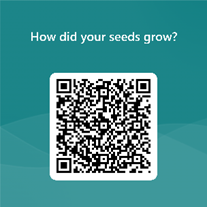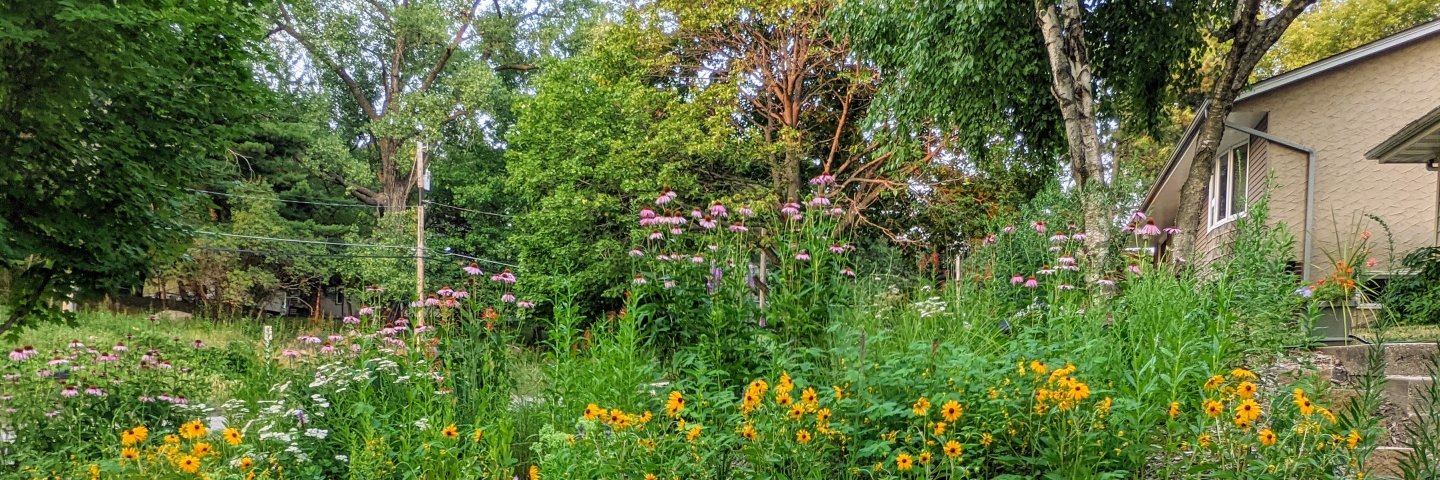Grow with us!
Are you ready to help Minnesota pollinators? If you received a State of Minnesota branded packet of native seeds, this planting guide is for you.
If you already used your seed packet, scan the QR code below and tell us about your planting experience.

Minnesota’s Interagency Pollinator Protection Team (IPPT) developed this seed mix, which contains:
| Type | Scientific name | Common name | % | Bloom time | Pollinator notes |
|---|---|---|---|---|---|
| Forb | Asclepias tuberosa | Butterfly milkweed | 8 | Summer | Host plant of monarch caterpillars. |
| Forb | Liatris ligulistylis | Meadow blazing star | 4 | Summer | One of the monarch’s favorite nectar plant. |
| Forb | Verbena stricta | Hoary vervain | 9 | Summer | Attractive to native bees and butterflies. Hosts at least one specialist bee. |
| Forb | Heliopsis helianthoides | Common ox-eye | 10 | Summer | Pollinators walk around the flower sipping nectar with their proboscises (mouths). |
| Forb | Monarda fistulosa | Wild bergamot | 5 | Summer | Provides a lot of nectar. Great for observing and photographing bumble bees! |
| Forb | Aquilegia canadensis | Red columbine | 4 | Spring | An early bloomer attractive to bees, hummingbirds, butterflies, and moths. |
| Forb | Zizia aurea | Golden Alexanders | 5 | Spring | A pollen and nectar source for early emerging bees during spring. |
| Forb | Rudbeckia hirta | Black-eyed Susan | 11 | Summer | A long flowering nectar source. Some birds like to eat their seeds. |
| Forb | Dalea purpurea | Purple prairie clover | 14 | Summer | Great for observing native bees collect pollen. Look for vibrant orange pollen on bees’ legs and underside! |
| Forb | Symphyotrichum laeve | Smooth blue aster | 5 | Fall | Provides food for bees and butterflies during late fall. |
| Grass | Schizachyrium scoparium | Little bluestem | 25 | Summer | Host plant of grass skipper caterpillars. Provides pollinator nesting habitat. |
Where to start?
- Plant your seeds during late fall, spring, or early summer. Many native seeds need winter conditions to break their dormancy before they will emerge. Planting in fall may reduce competition from other plants.
- Select a site. Plant in a small area or in containers in an area that receives 6 to 8 hours of sun per day. One seed packet contains enough seeds to cover 10 square feet.
- Prepare your soil. Remove existing vegetation to reduce competition with other plants. There is no need to add fertilizers, as native plants are adapted to poor soils.
- Provide seed-to-soil contact. Spread seeds directly onto the soil surface and gently rake or press them into soil. Do not cover with too much soil – a soil depth equal to the thickness of the seed is just right!
- Water. You do not need to water the seeds as long as they receive about one inch of rainfall per week.
- Be patient. Native plants put most of their energy into building strong roots the first few years.
- Tell us about your planting experience here!
Go the extra mile!
Provide flowers all season long
Pollinators need pollen and nectar throughout the growing season! Early spring flowers like golden alexanders and large beardtongue, and blooming shrubs like wild plum and willows, are critical food sources for early-emerging pollinators. Late-flowering species like asters and goldenrods provide nectar for insects that overwinter, including young bumble bee queens and migratory monarch butterflies.
Offer nesting habitat
In addition to nectar and pollen, optimal pollinator habitat includes areas for overwintering and nesting. Undisturbed areas that may be used for pollinator nesting include downed logs, bunch grasses, leaf litter, hollow stems, and areas of bare soil. While native grasses—such as the little bluestem in this mix—don’t provide nectar for pollinators, they serve as nesting habitat for several pollinator species!
Minimize pesticide use
- Identify your garden insects: which are pests and which are beneficial?
- Accept some insect damage on plants.
- Use pesticides only when necessary. If you need to apply pesticides:
- Look for the pollinator protection box on insecticide labels and follow the label exactly. The label is the law.
- Apply when bees are not foraging (early morning or evening, or when air temperatures are below 55°F).
- Prevent drift when applying pesticides. Avoid applying pesticides when it is windy.
Additional resources
- For more information about installing pollinator habitat, check out the Pollinator Toolbox from the Minnesota Board of Water and Soil Resources.
- For more native plant suggestions:
- The Xerces Society regional Pollinator-Friendly Native Plant Lists
- The Great Lakes Region and the Northern Plains Region provide suggestions appropriate for Minnesota.
- Minnesota DNR's draft Pollinator Resource Values for Upland & Wetland Prairies (printable booklet version) has additional suggestions for open, full-sun gardens and recreating diverse prairie.
- BWSR’s Pollinator Toolbox- Plants and Seed Mixes page includes tree and shrub suggestions!
- The Minnesota Department of Agriculture has developed best management practices for yards, gardens, and pesticide use with a focus on pollinator protection.
- The annual Minnesota State Agency Pollinator Report is available on EQB’s Pollinators page.
- Map your self-installed pollinator project on Blue Thumb website.
Last updated: 3/26/2024
